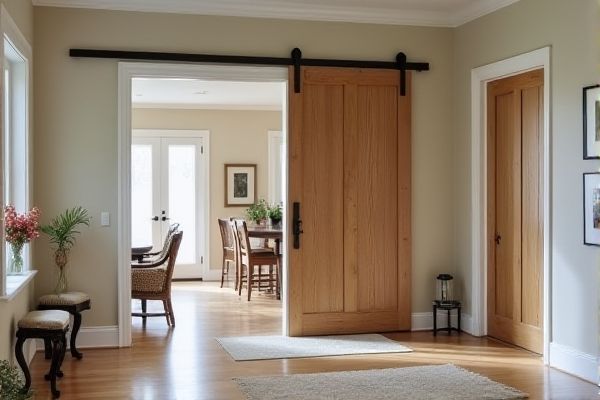
Barn doors offer a rustic aesthetic and easy installation since they slide along the exterior wall, saving floor space, while pocket doors slide into the wall cavity, providing a clean, unobtrusive look but requiring more complex installation. Discover which door type best suits Your space and style by reading the rest of the article.
Table of Comparison
| Feature | Barn Doors | Pocket Doors |
|---|---|---|
| Installation | Surface-mounted on wall via a track system | Slides into a wall cavity, requiring wall modification |
| Space Efficiency | Saves floor space but requires wall clearance | Maximizes space by disappearing into the wall |
| Aesthetics | Rustic, industrial, or modern look; visible hardware | Clean, minimalist look with hidden door |
| Privacy & Sound Insulation | Less effective due to gap and wall-mounted | Better soundproofing and privacy |
| Cost | Moderate; cheaper installation and hardware | Higher; complex installation and materials |
| Maintenance | Easy to maintain and repair hardware | More challenging due to hidden track and wall cavity |
| Common Uses | Bedrooms, closets, rustic or modern interiors | Bathrooms, small rooms, spaces needing minimal clutter |
Barn Doors vs Pocket Doors: An Overview
Barn doors offer a rustic aesthetic with exposed sliding hardware, ideal for saving wall space and adding a decorative element, while pocket doors slide seamlessly into the wall cavity, providing a sleek, space-saving solution without visible tracks. Barn doors require wall clearance alongside the opening, limiting furniture placement, whereas pocket doors demand more complex installation and wall modifications but maximize usable room space. Both options enhance interior design choices depending on space constraints, style preferences, and functional needs in residential or commercial settings.
Design and Aesthetic Appeal
Barn doors offer a rustic, farmhouse charm with their exposed hardware and solid wood panels, creating a bold focal point in any room. Pocket doors provide a sleek, minimalist look by sliding discreetly into the wall, maximizing space without interrupting the visual flow. Both options enhance interior design, but barn doors emphasize texture and character, while pocket doors prioritize clean lines and modern sophistication.
Space-Saving Capabilities
Barn doors and pocket doors both excel in saving space, but pocket doors provide superior space efficiency by sliding entirely into the wall, eliminating the need for clearance space. Barn doors, while mounted on exterior tracks, require some wall space alongside the doorway and cannot be concealed when open. For tight rooms or narrow hallways, pocket doors maximize usable floor area, making them the optimal choice for compact living environments.
Installation Process and Requirements
Barn doors require mounting hardware along the wall surface, including a sturdy header board for the track, making installation relatively straightforward but necessitating sufficient wall space. Pocket doors need a wall cavity to slide into, requiring wall demolition or construction, which is more invasive and complex but hides the door completely when open. Your choice depends on the existing wall structure and the feasibility of either surface-mounted or recessed installation methods.
Cost Comparison
Barn doors typically cost between $200 and $1,200, depending on materials and hardware, while pocket doors range from $500 to $2,500 due to more complex installation requirements. Installation for pocket doors often demands wall modification and professional labor, increasing overall expenses compared to the relatively straightforward mounting of barn doors. Your choice will affect both upfront costs and potential remodeling expenses, with barn doors offering a more budget-friendly option.
Durability and Maintenance
Barn doors, often crafted from solid wood or metal, offer robust durability with minimal hardware exposure, reducing the risk of mechanical failure and making maintenance straightforward. Pocket doors, while space-saving and sleek, rely on recessed tracks and rollers that may require frequent lubrication and occasional alignment to prevent wear and ensure smooth operation. Choosing based on your maintenance preferences and space constraints can help you maximize door longevity and ease of upkeep.
Soundproofing and Privacy
Barn doors offer limited soundproofing due to their typically single-panel design and gaps around the frame, which can reduce privacy. Pocket doors slide into the wall cavity, providing a tighter seal that enhances noise reduction and improves privacy. For environments requiring better acoustic separation, pocket doors generally outperform barn doors.
Suitability for Different Room Types
Barn doors are ideal for adding a rustic or industrial touch to living rooms, bedrooms, and dining areas where wall space is available for sliding hardware. Pocket doors suit small or narrow rooms like bathrooms, closets, and laundry rooms by sliding discreetly into the wall, maximizing usable space. Your choice depends on room layout and decor style, balancing aesthetic appeal with functional space-saving needs.
Pros and Cons of Barn Doors
Barn doors offer a stylish, rustic aesthetic and save floor space since they slide along the wall rather than swinging open. They are easier to install on standard walls and provide quick access, but they do not seal as tightly, which can affect privacy and sound insulation. Their exposed hardware design may not suit all interior styles, and wall clearance is necessary to accommodate the door's slide path.
Pros and Cons of Pocket Doors
Pocket doors save space by sliding into the wall, making them ideal for small rooms or tight hallways. They offer a sleek, modern aesthetic but can be challenging to install and maintain due to hidden track mechanisms. Limited insulation and soundproofing compared to traditional doors are common drawbacks.
 homyna.com
homyna.com